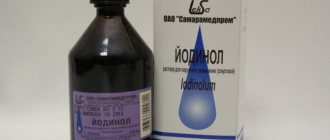Causes of tightness in the throat
A feeling of tightness in the throat can appear under the influence of various factors, which are divided into 2 main categories - somatic and psychogenic. The first group of reasons is considered the most extensive and occurs most often.
Inflammatory processes in the throat area
Any inflammation provokes swelling of the tissues, as a result of which a person develops a pressing lump in the throat. This process can be acute or chronic and indicate the development of laryngitis or pharyngitis. Also, the reason may lie in the appearance of follicular tonsillitis.
In some cases, the patient's condition worsens and paratonsillitis or an abscess develops. This situation poses a serious danger, since there is a risk of severe edema, which will create difficulties with the access of oxygen to the organs of the respiratory system.
Tumor formations
Constriction may be associated with the development of benign or malignant tumors. And if in the first case conservative methods of therapy are usually sufficient, then in the second the situation can be much more serious. For treatment to be successful, the disease must be treated at the initial stage of development.
In some cases, a feeling of choking in the throat is the only sign of a dangerous disease. However, in some cases additional symptoms occur:
- rapid fatigue of the ligaments during a conversation;
- difficulty swallowing;
- the appearance of hoarseness in the voice;
- bad breath;
- formation of bloody streaks in sputum;
- breathing problems;
- the appearance of shooting pain in the ear.
Most often, such problems are localized in the larynx, trachea or oropharynx. If you suspect the presence of tumor formations, you should immediately contact a specialist.
Thyroid dysfunction
With iodine deficiency there is a risk of damage to the thyroid gland. This organ increases in size and compresses the throat. This pathology is called goiter. The second name is Graves' disease.
To identify pathology, the doctor conducts an examination. In addition to visual signs, people experience decreased appetite, protruding eyes, and weight loss. To clarify the diagnosis, laboratory tests and ultrasound are prescribed.
Also, a feeling of choking in the throat is sometimes associated with other lesions of the thyroid gland - inflammatory processes or increased production of thyroid hormones. These pathologies are also accompanied by a sensation of a foreign object in the throat.
Osteochondrosis
Quite often there is pressure in the throat with the development of cervical osteochondrosis. The causes of this disorder are most often associated with lack of movement, poor diet and bad habits.
Cervical osteochondrosis is accompanied by pain in the back, head and neck. In some cases, the pathology even provokes nausea, vomiting, and pressure changes. Only a doctor can diagnose the disease.
To cope with the pathology, long-term treatment is carried out. Therapeutic gymnastics and massage are highly effective. You definitely need to watch your posture. For sleeping, you should use an orthopedic pillow and mattress. In difficult cases, it is not possible to do without medications.
Digestive system diseases
If your throat is choking, the reasons may be due to gastroenterological problems. If this symptom appears after eating, there is a very high probability of developing pathologies of the digestive system.
Endocrine pathology
Difficulty swallowing, a feeling of pressure in the throat, is also characteristic of thyroid pathology. Normally, this organ is located below the thyroid cartilage and is almost invisible when examining the patient. However, some diseases may be characterized by an increase in the size of this formation, that is, the formation of a goiter.
Since the enlarged thyroid gland is adjacent to the larynx, it puts pressure on it, causing the development of symptoms. There are several degrees of enlargement of the thyroid gland. Depending on its size, the patient’s complaints may also worsen. At a certain size, the gland can put pressure on the surrounding tissues, larynx, trachea, cause a feeling of pressure in the throat, make it difficult to breathe, and make swallowing difficult.
The most common thyroid diseases are:
- endemic goiter;
- sporadic goiter;
- thyroid tumors;
- diffuse toxic goiter;
- hypothyroidism
The thyroid gland, through the production of its hormones, participates in metabolic processes occurring in the body. Pathological processes occurring in the thyroid gland can be characterized by normal levels of hormones, decreased release into the blood, or increased levels, which affects the development and nature of clinical manifestations.
Hypothyroidism is characterized by decreased hormone levels. In this regard, there is a slowdown in metabolic processes occurring in the body. Such patients are characterized by lethargy, drowsiness, hoarseness, dry skin, weight gain, constipation, and bradycardia.
A life-threatening complication is hypothyroid coma. Patients complain that it becomes difficult to breathe, convulsions appear, signs of brain failure, and breathing slows down.
An increase in the level of thyroid hormones is accompanied by symptoms such as nervousness, sweating, irregular heartbeat, tachycardia, and weight loss. Disturbances in the production of hormones can be characterized by an increased size of the gland or occur with its unchanged volume. In such cases, it is the presence of clinical signs of the disease that forces you to see an endocrinologist and undergo an examination for the level of thyroid hormones. Timely correction of this condition will lead to significant improvement.
At the same time, the presence of a goiter is not always accompanied by changes in the hormonal levels of the gland. Even in the absence of clinical signs indicating a lack or excessive amount of hormones, an enlarged thyroid gland is a reason to conduct an ultrasound examination. This symptom may be a consequence of a lack of iodine in the body, as well as the result of the development of benign or malignant tumors. Timely diagnosis of this condition will help to avoid a severe course of the disease.
Under the influence of arthrosis changes, nerve fibers and vessels located in the spinal column can be compressed. As a result of this, certain parts of the neck and head receive insufficient nutrition, which can also be manifested by complaints of squeezing the throat, a feeling of a lump. Osteochondrosis of the cervical spine is a common cause of this symptomatology.
Clinical picture (symptoms)
A feeling of tightness is quite rarely the only symptom. As a rule, this condition is accompanied by an extensive list of additional symptoms, which helps specialists make an accurate diagnosis. The most common manifestations include the following:
- discomfort during a conversation;
- pain syndrome that creates difficulty breathing and swallowing;
- a feeling of heaviness in the occipital region, headaches, fainting - associated with oxygen deficiency due to damage to the arteries;
- numbness of the extremities - may be associated with circulatory deficiency or neurological factors.
Additional symptoms
The feeling of suffocation rarely appears as a single symptom. In most cases, this complaint is accompanied by a wide range of additional signs of a disease, which helps the doctor in diagnosis.
Also, due to the small space of the neck, which contains a large number of vital organs, suffocation is often caused by several different pathologies developing simultaneously. A person may additionally complain of the following symptoms:
- the appearance of a feeling of discomfort during a conversation or such a feeling that appears if you have to talk for too long;
- a feeling as if a lump has formed in the throat, which interferes not only with the respiratory process, but also with the act of swallowing; it is not possible to get rid of the lump;
- painful sensations can also accompany the act of swallowing, which is especially common with inflammatory diseases of the mucous membrane;
- due to a lack of oxygen when the arteries are injured, complaints of heaviness in the back of the head and headaches may appear; in case of severe circulatory disorders, episodes of loss of consciousness are also possible;
- a feeling of numbness in the limbs, which can be either neurological in nature or develop due to insufficient blood circulation.
The presence of additional symptoms that the patient complains about, in most cases, helps the doctor narrow down the search for causes. The main thing is that during an appointment with a specialist, the patient talks as fully as possible about what exactly is bothering him.
When a feeling of constriction in the throat appears, the doctor, when the patient seeks help, makes a differential diagnosis between various diseases. Based on the diagnostic results, the patient begins therapy, which should alleviate his condition and relieve unpleasant symptoms.
Depending on the type of pathology, treatment can be either conservative or surgical. It is important not to try to treat the feeling of suffocation on your own, since without an accurate diagnosis, at best, a person will simply waste time fighting the symptom rather than its cause, and in the worst case, it will provoke a worsening of his own condition.
Diagnostic features
If you experience tightness in your throat, you should immediately consult a physician. After the initial examination, the doctor will give recommendations for treatment or prescribe additional examinations. In some cases, consultation with a specialist is required - a surgeon, otolaryngologist, endocrinologist. Sometimes you have to contact a neurologist or gastroenterologist.
To accurately determine the causes of throat constriction, additional diagnostic tests can be prescribed:
- urine and blood tests;
- assessment of the condition of the thyroid gland - the list of tests should include determining the level of hormones in the blood and ultrasound;
- biochemical analysis;
- determining the condition of the cervical lymph nodes;
- CT scan;
- Magnetic resonance imaging;
- examination of the pharynx and oral cavity.
Other possible pathologies
In addition to the diseases already mentioned, other pathologies can lead to difficulty breathing and compression in the throat area.
For example, choking and a feeling of constriction in the throat are often the result of a severe allergic reaction. In this case, the patient is recommended to take drugs that have an antihistamine effect. Depending on additional allergy symptoms, nasal and eye drops may also be prescribed if there is a severe runny nose or watery eyes.
A variant of an allergic reaction with severe suffocation is anaphylactic shock. This condition requires urgent assistance from specialists who can carry out all the necessary measures. Anaphylactic shock is life-threatening and is an emergency condition, so when it develops, call an ambulance without trying to cope with the problem on your own.
Another common cause of choking and a feeling of constriction in the throat is a variety of pathologies of the thyroid gland, accompanied by its enlargement. The proliferation of thyroid tissue leads to compression of nearby structures, not posing a strong threat to life, but causing severe discomfort to the patient.
Treatment for thyroid diseases will be selected by the doctor depending on the type. So, for example, in case of hypothyroidism (lack of organ hormones), hormone replacement therapy and iodine preparations can be prescribed, and in case of hyperthyroidism (excess of produced hormones), anti-inflammatory drugs and antithyroid drugs are used (neutralize the effect of excess hormones). If the thyroid gland reaches an enormous size, the issue of removing the thyroid gland is decided.
In some cases, suffocation occurs due to an attack of bronchial asthma. Such an attack requires the use of short-acting beta-agonist inhalers. If a person has severe bronchial asthma, he is given medications based on glucocorticoids that stop negative processes in the lungs. If an attack of bronchial asthma cannot be controlled using conventional means, then it is also necessary to call an ambulance, which will provide emergency assistance to patients.
Methods for treating a feeling of choking in the throat
To cope with the feeling of tightness in the throat, it is imperative to treat the underlying pathology. The choice of medications and procedures directly depends on the diagnosis.
So, if the functioning of the thyroid gland is impaired, iodine preparations must be prescribed . If autoimmune thyroiditis is diagnosed, therapy is more complex. In some situations, a person has to take hormonal medications for the rest of his life.
If the reason lies in damage to the cervical spine, it will not be possible to do without therapeutic exercises . The doctor may also recommend physical therapy - vacuum treatment, manual techniques, reflexology, laser therapy. Normalizing your lifestyle and following the rules of a healthy diet is of no small importance.
The most dangerous condition is the formation of a malignant tumor. In such a situation, it will not be possible to do without radiation and chemotherapy. In some cases, there is a need for surgical intervention.
When gastroenterological problems occur, treatment consists of following a special diet and using medications. However, if a hernia forms in the esophagus, surgery may be necessary.
With the development of inflammatory lesions of the otolaryngological organs, it is necessary to evaluate the nature of the disease - it may be of viral or bacterial origin. Based on the results of the studies, antibacterial drugs or other medications may be prescribed.
In addition to the main therapy, gargling with infusions of medicinal plants, preparations containing iodine or salt can be used. All of these products are distinguished by pronounced anti-inflammatory and healing characteristics. In some situations, warming compresses will help to enhance drug therapy.
If the feeling of tightness in the throat is due to psychogenic factors, therapy involves the use of medications and psychotherapeutic agents. If a patient is diagnosed with depression, he is prescribed antidepressants and tranquilizers.
If breathing problems occur that are associated with the appearance of panic attacks, measures are taken to eliminate the symptoms of vegetative-vascular dystonia.
It is recommended to do breathing exercises on your own, which provides effective relaxation. To do this, you need to breathe with your stomach or use a bag, holding your breath for a certain time. The exact set of exercises will be selected by your attending physician.
When a coma occurs for the first time, you can perform several breathing exercises, trying not to focus attention on this condition. At the same time, it is important to control swallowing movements - they should not become more frequent. An additional remedy to improve the condition would be herbal infusion or tea. Subsequently, it is recommended to perform exercises for the muscle tissue of the neck and larynx.
How to get rid of the feeling of a lump in your throat
Causes and treatment
Before prescribing treatment, it is necessary to understand the reasons that provoked the deterioration of the condition. Do not forget that both dystonics and patients suffering from neuroses or phobias can also have organic pathologies - psycho-emotional experiences are not always to blame for poor health.
Thus, the following ailments can provoke a feeling of throat constriction:
- processes of inflammation in the throat (laryngitis, pharyngitis, etc.);
- thyroid disorders (associated symptoms include poor appetite and weight loss);
- osteochondrosis (accompanied by pain in various parts of the back, neck, head, as well as nausea and changes in blood pressure);
- digestive system disorders;
- injuries to the larynx or esophagus;
- allergic diseases;
- tumors (this may cause symptoms such as bloody sputum, hoarseness, ear pain).
We recommend reading: What causes your heart to beat in your throat?
If the diagnosis does not reveal diseases of the internal organs, the patient may be referred to a neurologist or psychotherapist, where certain psychogenic disorders are usually discovered.
To understand the causes of such disorders and eliminate unpleasant symptoms, the patient is prescribed psychotherapeutic sessions and drug therapy, including the use of antidepressants or tranquilizers.
During sessions, methods such as psychoanalysis, cognitive behavioral therapy, hypnosis, NLP, and autogenic training can be used. An important condition for psychotherapeutic treatment is the conscious desire for recovery of the patient himself.
Preventive actions
To prevent such problems from occurring, you need to adhere to a number of recommendations. Preventive measures should include the following:
- timely elimination of nasopharyngeal pathologies;
- active lifestyle, monitoring adherence to work and rest schedules, outdoor walks;
- eliminating bad habits - giving up alcoholic beverages and smoking;
- systematic preventive examinations by an endocrinologist;
- adequate treatment of thyroid pathologies;
- maintaining a normal level of humidity in the room to prevent dry throat;
- timely treatment of chronic tonsillitis and systematic rinsing of the tonsils;
- treatment of pathologies of the digestive system;
- rinsing the nasal cavity with saline solutions;
- prevention and therapy of pathologies of the cervical spine;
- exclusion of stressful situations;
- timely treatment of pathology when the first signs appear.
A feeling of tightness in the throat may indicate the development of a variety of diseases. For treatment of this condition to be successful, it is very important to identify the causes of the problem. To do this, you need to consult a doctor who will conduct a detailed diagnosis and, based on its results, select the optimal therapy.
Diagnostic measures
Diagnostic measures carried out for complaints of compression in the throat area often play a decisive role. The doctor is obliged to pay attention to the patient’s complaints, medical history, and the time of the first symptoms.
Depending on additional symptoms, examinations will be prescribed. If diphtheria is suspected, the doctor must prescribe a throat smear. For injuries of the cervical spine, an x-ray is recommended, CT and MRI are possible. If a tumor is suspected, a biopsy will be performed to determine the type of tumor.
Based on the results of diagnostic examinations, a diagnosis is made, and only then treatment measures begin. Treatment based solely on symptoms will only bring a temporary effect, without protecting the person from the possible consequences of the disease.
Treating a symptom at home without a clearly established diagnosis is unacceptable. It can be dangerous in the case of acute conditions, such as severe diphtheria, anaphylactic shock, or a severe attack of bronchial asthma. Be careful if a symptom appears and consult a doctor!
And a little about secrets...
If you or your child are often sick and are treated with antibiotics alone, know that you are only treating the effect, not the cause.
So you simply “spare” money to pharmacies and pharmaceutical companies and get sick more often.
STOP! Stop feeding unknown people!!! You just need to boost your immunity and you will forget what it’s like to be sick!
Many people do not know what to do in a situation where they feel as if they are being suffocated by an unpleasant sensation in the thyroid area.
A feeling of acute lack of air often torments patients with.
The trachea experiences pressure from the grown goiter, which may cause a sensation of a foreign body in the throat area.
The brain sends nerve impulses to the body, including protective reflexes: a cough appears, a burning sensation in the respiratory tract, and the voice may disappear.
These symptoms most often signal morphological changes in the parenchyma of the gland, and sometimes also indicate functional insufficiency of the thyroid gland.
In some cases, lack of air can be caused by thyroid cancer, which is why it is so important to start treating shortness of breath on time.
Swelling of the mucous membrane
Swelling affecting the mucous membrane is not considered an independent type of disease, but acts as an additional symptom. As in the case of tumors, the cause of suffocation is mechanical: swelling of the mucous membrane develops, which leads to a narrowing of the lumen of the larynx, which means less oxygen enters the body.
Swelling of the mucous membrane of the throat can occur due to injuries, after burn wounds, as a result of severe infectious diseases or allergic reactions. Depending on the cause of the swelling, treatment will be selected.
Very often, swelling of the larynx is accompanied by pain, which appears either in response to swallowing or when talking. This occurs due to the fact that the mucous membrane becomes especially susceptible to irritants, and any movement acts as an additional irritating factor.
Swelling of the mucous membrane rarely develops at lightning speed (mostly this occurs during a violent allergic reaction). More often, the patient’s complaints appear rather slowly, gradually.
The choice of treatment method depends on what is the main cause of the development of edema. So, for example, if the trigger factor is a virus, then the patient is prescribed antiviral drugs, restorative medications, and vitamin complexes. If there is a temperature, it is brought down to normal or slightly elevated values.
Article on the topic - sore throat and lost voice: what to do?
If choking and a feeling of constriction in the throat are caused by a sore throat, then the patient must be prescribed drugs from the group of antibiotics and antiseptics. Treatment with antibiotics is considered mandatory for angina; you should not neglect it, so as not to encounter possible complications.
If the cause of swelling of the mucous membrane cannot be immediately determined, the patient may be prescribed anti-inflammatory drugs. These medications help relieve swelling of the throat, and therefore relieve the symptom of suffocation.
Article on the topic - a list of the best antiviral drugs.










